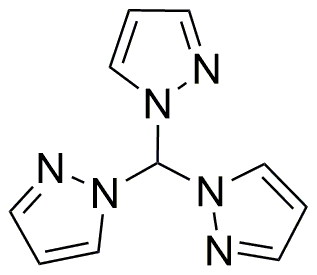Tris(1-pyrazolyl)methane is widely utilized in research focused on:
- Catalysis: This compound serves as a versatile ligand in catalytic processes, enhancing the efficiency of various chemical reactions, particularly in organic synthesis.
- Coordination Chemistry: It forms stable complexes with transition metals, making it valuable in the development of new materials and in the study of metal-ligand interactions.
- Analytical Chemistry: Used as a reagent in the detection and quantification of metal ions, it provides a reliable method for environmental monitoring and quality control in industrial processes.
- Pharmaceutical Research: Its unique structure allows for the exploration of new drug candidates, particularly in targeting specific biological pathways, thus aiding in the development of novel therapeutics.
- Material Science: The compound is applied in the synthesis of advanced materials, such as polymers and nanomaterials, which have applications in electronics and nanotechnology.
General Information
Properties
Safety and Regulations
Applications
Tris(1-pyrazolyl)methane is widely utilized in research focused on:
- Catalysis: This compound serves as a versatile ligand in catalytic processes, enhancing the efficiency of various chemical reactions, particularly in organic synthesis.
- Coordination Chemistry: It forms stable complexes with transition metals, making it valuable in the development of new materials and in the study of metal-ligand interactions.
- Analytical Chemistry: Used as a reagent in the detection and quantification of metal ions, it provides a reliable method for environmental monitoring and quality control in industrial processes.
- Pharmaceutical Research: Its unique structure allows for the exploration of new drug candidates, particularly in targeting specific biological pathways, thus aiding in the development of novel therapeutics.
- Material Science: The compound is applied in the synthesis of advanced materials, such as polymers and nanomaterials, which have applications in electronics and nanotechnology.
Documents
Safety Data Sheets (SDS)
The SDS provides comprehensive safety information on handling, storage, and disposal of the product.
Product Specification (PS)
The PS provides a comprehensive breakdown of the product’s properties, including chemical composition, physical state, purity, and storage requirements. It also details acceptable quality ranges and the product's intended applications.
Certificates of Analysis (COA)
Search for Certificates of Analysis (COA) by entering the products Lot Number. Lot and Batch Numbers can be found on a product’s label following the words ‘Lot’ or ‘Batch’.
Numéro de catalogue
Numéro de lot/série
Certificates Of Origin (COO)
This COO confirms the country where the product was manufactured, and also details the materials and components used in it and whether it is derived from natural, synthetic, or other specific sources. This certificate may be required for customs, trade, and regulatory compliance.
Numéro de catalogue
Numéro de lot/série
Safety Data Sheets (SDS)
The SDS provides comprehensive safety information on handling, storage, and disposal of the product.
DownloadProduct Specification (PS)
The PS provides a comprehensive breakdown of the product’s properties, including chemical composition, physical state, purity, and storage requirements. It also details acceptable quality ranges and the product's intended applications.
DownloadCertificates of Analysis (COA)
Search for Certificates of Analysis (COA) by entering the products Lot Number. Lot and Batch Numbers can be found on a product’s label following the words ‘Lot’ or ‘Batch’.
Numéro de catalogue
Numéro de lot/série
Certificates Of Origin (COO)
This COO confirms the country where the product was manufactured, and also details the materials and components used in it and whether it is derived from natural, synthetic, or other specific sources. This certificate may be required for customs, trade, and regulatory compliance.


